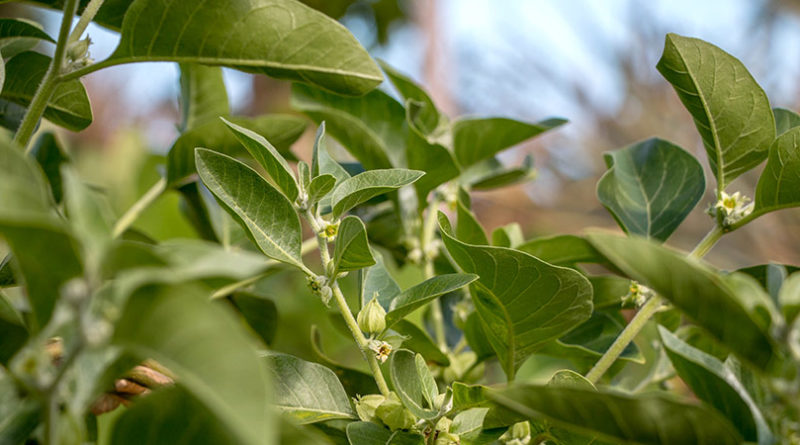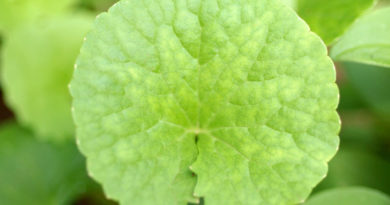Benefits of Ashwagandha
Ashwagandha
Botanical: Withania somnifera, Solanaceae
S: Ashgandh
E: Winter Cherry
Part used: root
Energetics:
- Rasa: tikta/bitter; kashaya/astringent
- Virya: ushna/hot
- Vipaka: katu/pungent
- Guna: ruksha/dry, laghu/light
- Dosha: VK-
- Dhatu/Tissues: Rakta/Blood, Muscle/Mamsa, Fat/Medas, Bone/Asthi, Nerve/Majja, Reproductive/Shukra-Artava
- Srotas/Systems: Reproductive/Artava-Shukravaha, Nervous/Majjavaha, Respiratory/Pranavaha
Ayurvedic Action: medhya/promotes the intellect, nidrajanana/promotes sleep, stanyajanana/increases strength, vedanasthapana/reduces pain, balya/increases strength, vajikarana/aphrodesiac, rasayana/rejuvenative for VK, Vatakaphahara/reduces VK (Srikanthamurthy 2001, 258; Warrier et al 1996, 409; Dash 1991, 59)(Pole, 2006).
Starting dosage: 3-9g per day dried root or 6-15ml per day of a 1:3 @ 45% tincture. (Pole) 3-15 g per day dried root or 1-15 mL fresh root, 1:2 @ 95%; dried root, 1:3; 35% tincture.
Constituents:
Steroidal Compounds: ergostane-type steroidal lactones, including withanolides A-Y, dehydrowithanolide-R, withasomniferin-A, withasomidienone, withasomniferols A-C, withaferin A, withanone and others.
Other constituents: phytosterols sitoindosides VII-X and beta-sitosterol.
Alkaloids (e.g. ashwagandhine, cuscohygrine, tropine, pseudotropine, isopelletierine, anaferine), a variety of amino acids including tryptophan, and high amounts of iron (Williamson 2003, 322; Yoganarasimhan 2000, 592; Mills and Bone 2000, 596).
Biomedical indications: Anorexia, bronchitis, asthma, consumption, leucoderma, edema, asthenia, anemia, exhaustion, aging, insomnia, ADD/ADHD, infertility, impotence, repeated miscarriage, paralysis, memory loss, multiple sclerosis, immune dysfunction, cancer, rheumatism, arthritis, lumbago.
Precautions: Caution should be used with clients on anticonvulsants, barbituates and benzodiazepines due to its GABA-nergic and sedative properties. Ashwagandhais traditionally avoided in lymphatic congestion, during colds and flu, or symptoms of ama (Frawley and Lad 1986, 160).
Research highlights:
Adaptogen: The traditional use of Ashwagandha as an adaptogen has been assessed. Researcher found that rats treated with an extract of Withania somnifera showed better stress tolerance in cold water swimming tests, a classic experimental model of adaptogenic activity (Archana and Namasivayam 1999).
Antiinflammatory: A methanolic extract of the aerial parts of Withania somnifera had antiinflammatory activities comparable to that of hydrocortisone sodium succinate in rats subjected to subcutaneous cotton-pellet implantation (al-Hindawi et al 1992). An 80% ethanolic extract of Withania somnifera displayed significant antiinflammatory activity on carrageenan-induced paw edema in rats (al-Hindawi 1989).
Antioxidant: An aqueous suspension of root extract of Ashwagandha prevented the rise of experimentally induced lipid peroxidation in rabbits and mice (Dhuley 1998a). An extract of Withania somnifera, consisting of equimolar concentrations of sitoindosides VII-X and withaferin A, induced an increase in the levels of superoxide dismutase, catalase and glutathione peroxidase in rat brain, consistent with other research that reports an antioxidant, immunomodulant and antiinflammatory activity (Bhattacharya et al 1997).
Cancer: The steroidal lactone withaferin A displayed significant antitumor and radiosensitizing effects, inhibiting tumor growth and increasing survival in Swiss mice inoculated with Ehrlich ascites carcinoma (Devi et al 1995; Sharad et al 1996). The administration of an extract of Withania somnifera was found to significantly reduce leucopenia induced by cyclophosphamide treated experimental animals, indicating its usefulness in cancer therapy (Davis and Kuttan 1998). The administration of methanolic extract of Ashwagandha was found to significantly increase the WBC count in normal Balb/c mice and reduce leucopenia induced by a sublethal dose of gamma-radiation. Withania increased bone marrow cellularity and normalised the ratio of normochromatic erythrocytes and polychromatic erythrocytes. This observed activity was thought to be due to stem cell proliferation (Kuttan 1996).
Central Nervous system: Isolated constituents of Withania somnifera (sitoindosides VII-X and withaferin-A) increased cortical muscarinic acetylcholine receptor capacity, partly explaining the cognition-enhancing and memory-improving effects traditionally attributed to Ashwagandha (Schliebs et al 1997). A methanolic extract of Withania somnifera inhibited the specific binding of [3H]GABA and [35S]TBPS, and enhanced the binding of [3H]flunitrazepam to their putative receptor sites, suggesting a GABA-mimetic activity (Mehta et al 1991). A commercial root extract of Withania somnifera used repeatedly over nine days attenuated the development of tolerance to the analgesic effect of morphine and suppressed morphine-withdrawal jumps (Kulkarni and Ninan 1997).
Diabetes: The hypoglycemic, diuretic and hypocholesterolemic effects of roots of Ashwagandha were assessed in six patients with mild NIDDM and six patients with mild hypercholesterolemia. The treatment consisted of the powder of roots over a 30 day period. At the end of the study, researchers noted a decrease in blood glucose comparable to that of an oral hypoglycemic drug, and a significant increase in urine sodium and urine volume, coupled with a decrease in serum cholesterol, triglycerides, LDL (low density lipoproteins) and VLDL (very low density lipoproteins) cholesterol, with no adverse effects noted (Andallu and Radhika 2000).
Immunity: Myelosuppressed mice treated with an extract of Ashwagandha displayed a significant increase in hemoglobin concentration, red blood cell count, white blood cell count, platelet count and body weight as compared to controls, as well as increased hemolytic antibody responses towards human erythrocytes (Ziauddin et al 1996). Researchers at the Amala Cancer Research Centre in Kerala, India, found that the administration of an extract from the powdered root of Withania somnifera enhanced the levels of interferon-?, interleukin-2 and granulocyte macrophage colony stimulating factor in normal and cyclophosphamide-treated mice, suggesting an immunopotentiating and myeloprotective effect (Davis and Kuttan 1999). Mice infected intravenously with Aspergillus fumigatus and treated for 7 consecutive days with an oral preparation of an extract of Withania somnifera at a dose of 100mg/kg displayed increased phagocytic activity and prolonged survival time (Dhuley 1998). The antifungal activity of Withania has been confirmed elsewhere, attributed to the withanolides (Choudhary et al 1995).
Musculo-skeletal: A herbomineral formulation containing roots of Withania somnifera, the stem of Boswellia serrata, rhizomes of Curcuma longa and a zinc complex (Articulin-F), was evaluated in a randomized, double-blind, placebo controlled, cross-over study in clients with osteoarthritis. The results produced a significant drop in severity of pain and disability, although radiological assessment did not show any significant changes. Side effects were minimal and did not necessitate the withdrawal of treatment. (Kulkarni et al 1991).
References
Caldecott, Todd, Herbal Profiles on www.toddcaldecott.com
Frawley, Dr. David, Lad, Dr. Vasant, The Yoga of Herbs, 2001 by Lotus Press
Pole, Sebastian, Ayurvedic Medicine, 2006 by Churchill Livingstone
Tillotson, Alan Keith, The One Earth Herbal Sourcebook, 2001 by Kensington Books
Tirtha, Swami Sada Shiva, The Ayurveda Encyclopedia, 1998 Ayurveda Holistic Center Press
Tierra, Michael, Planetary Herbology, 1998 by Lotus Press




